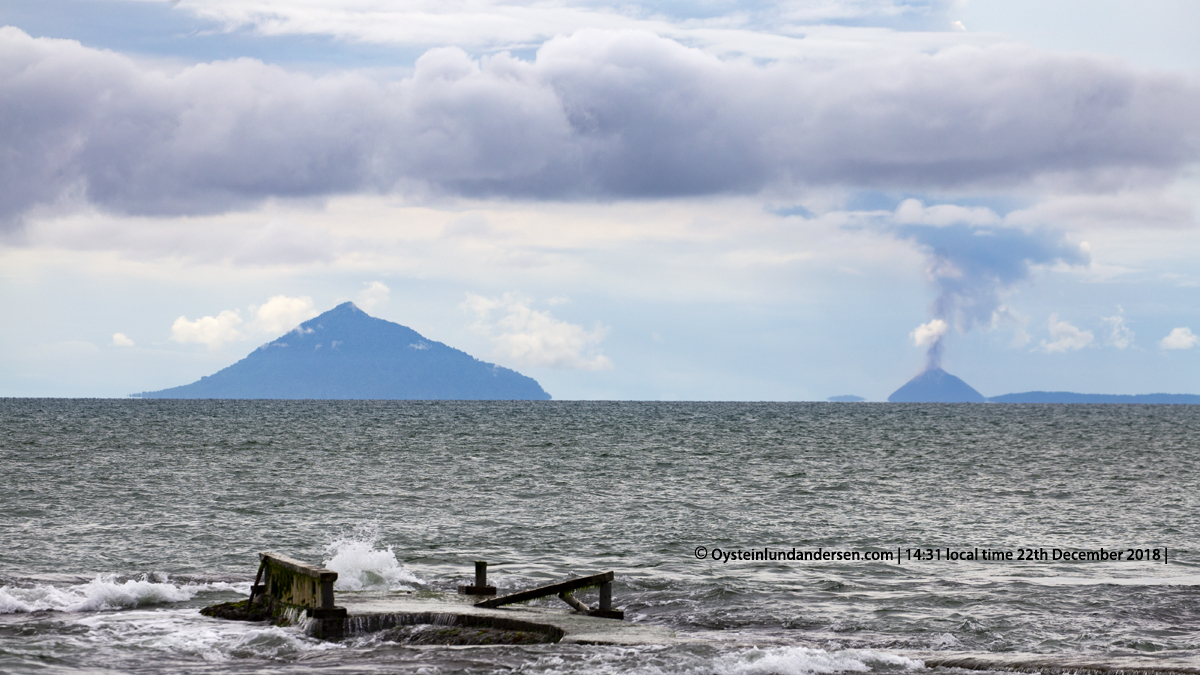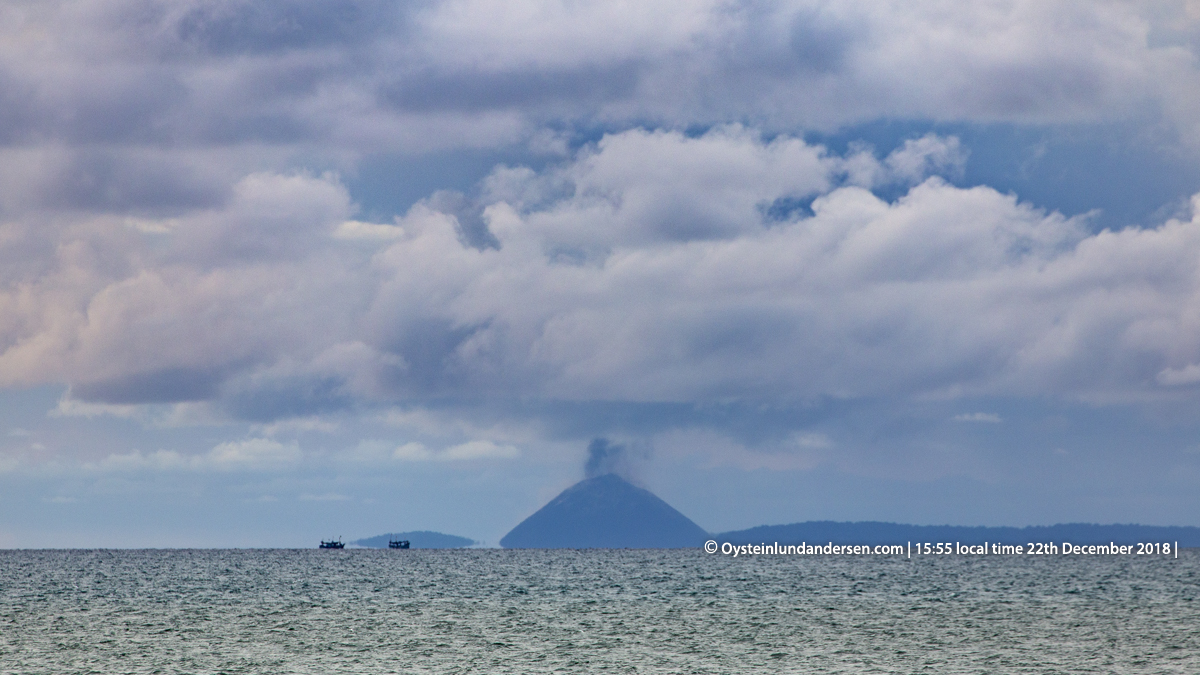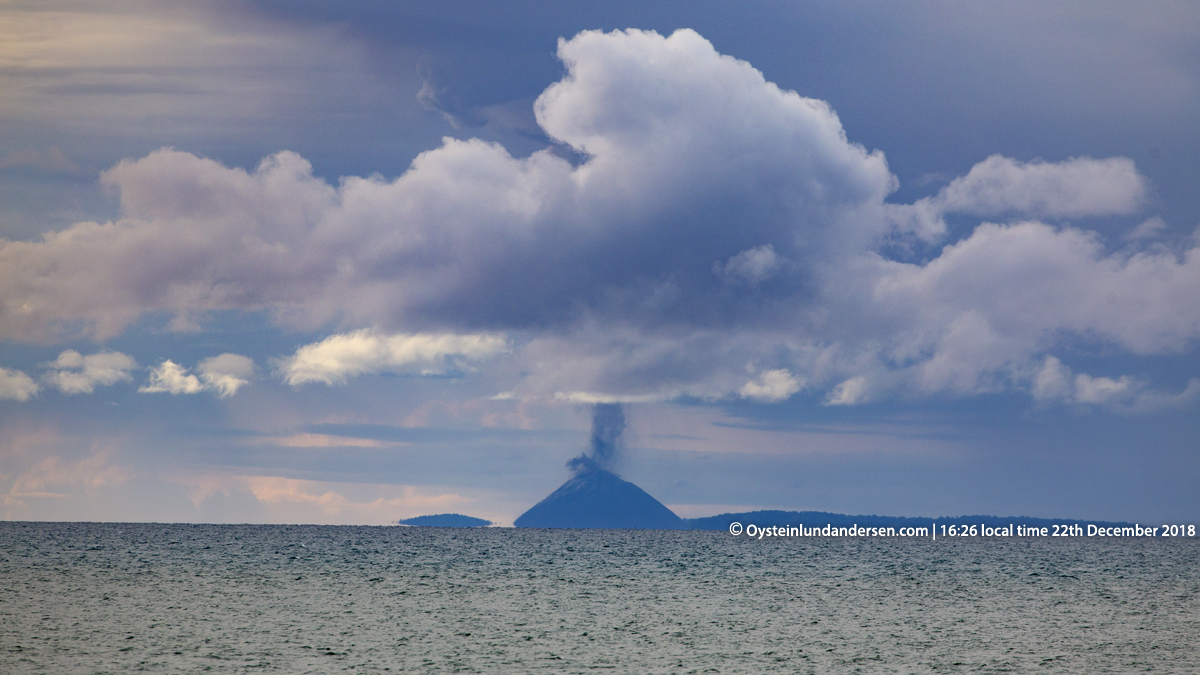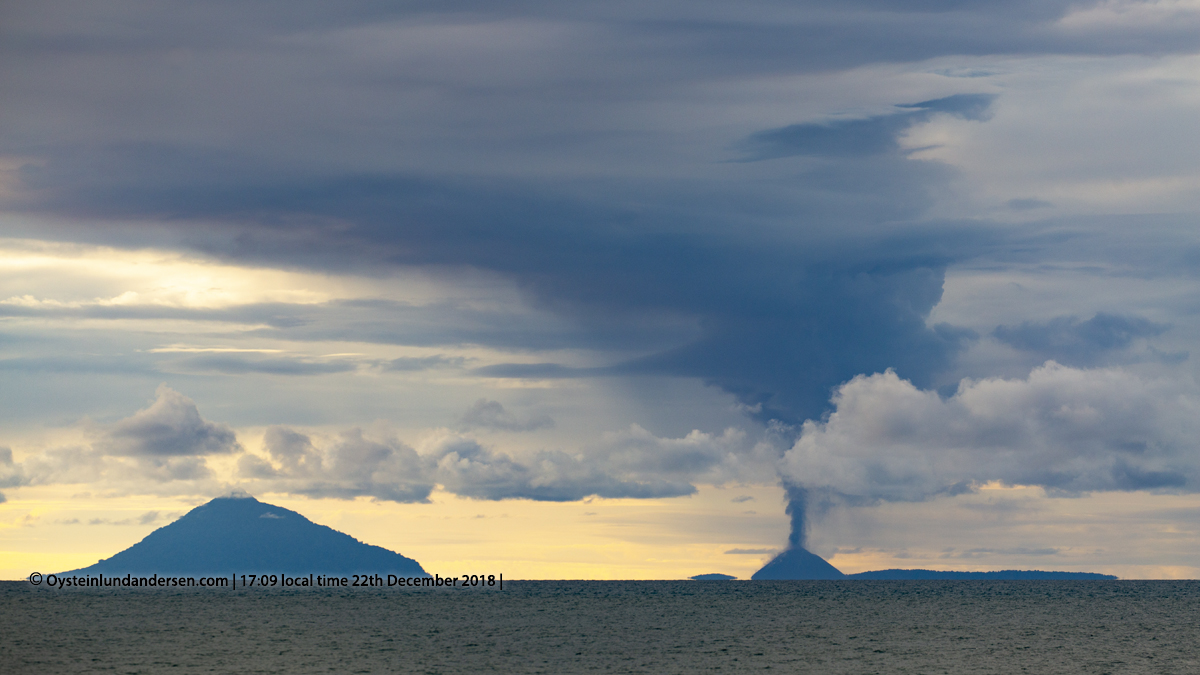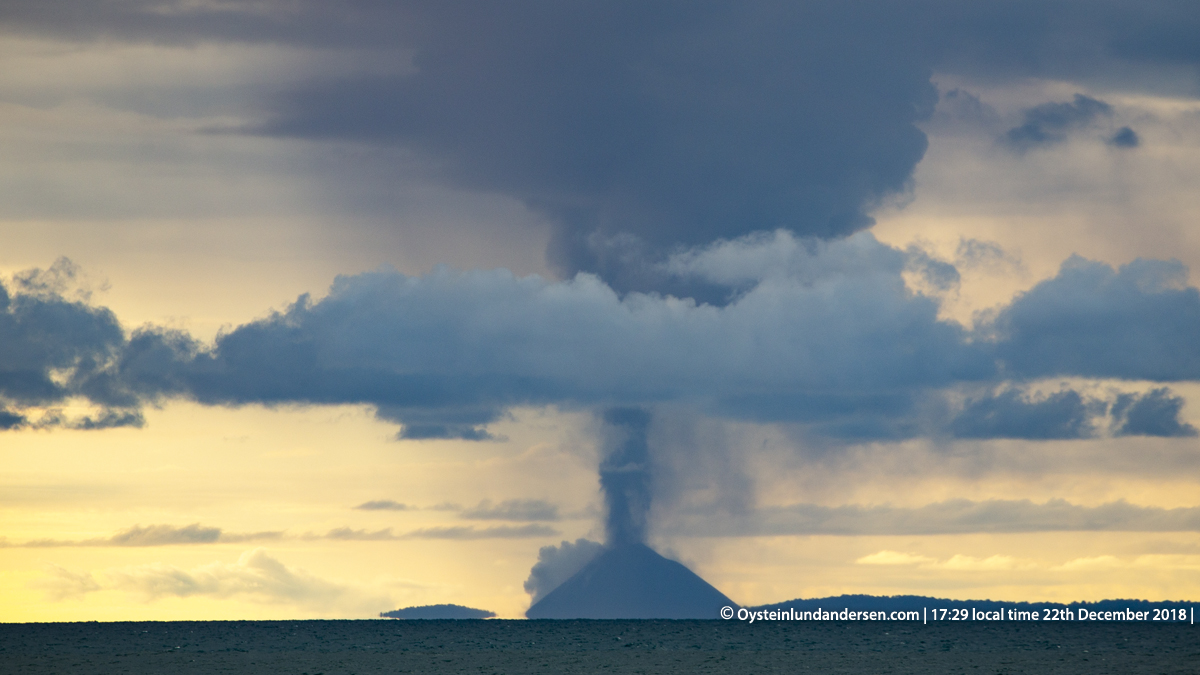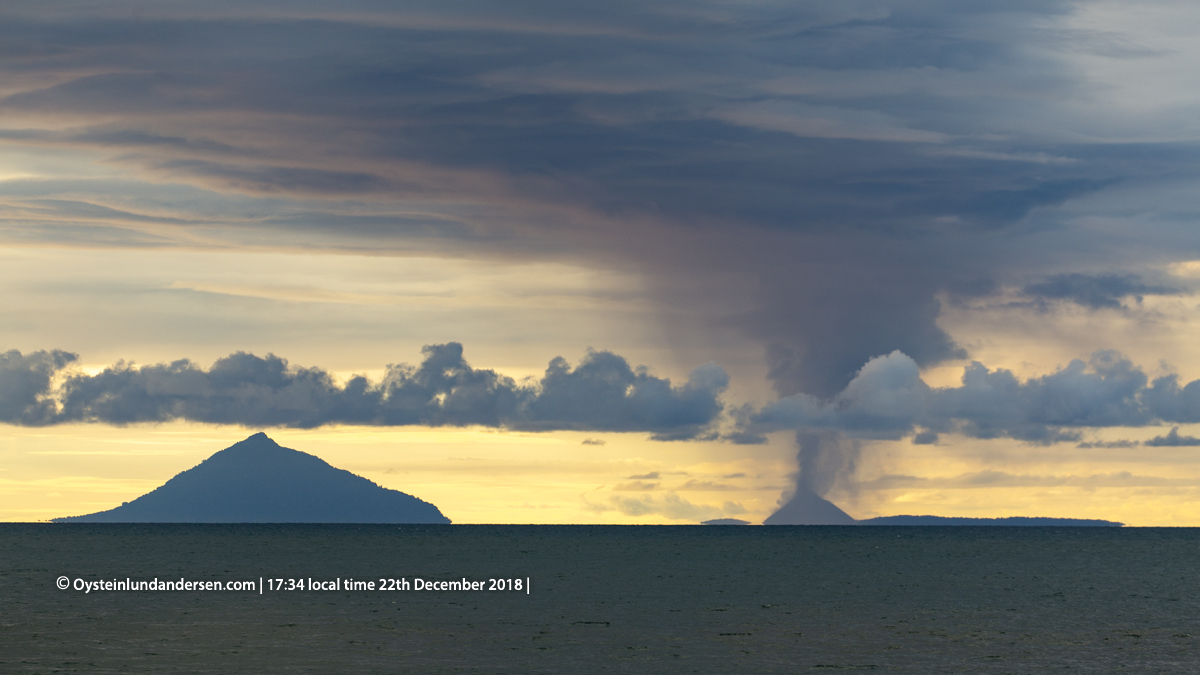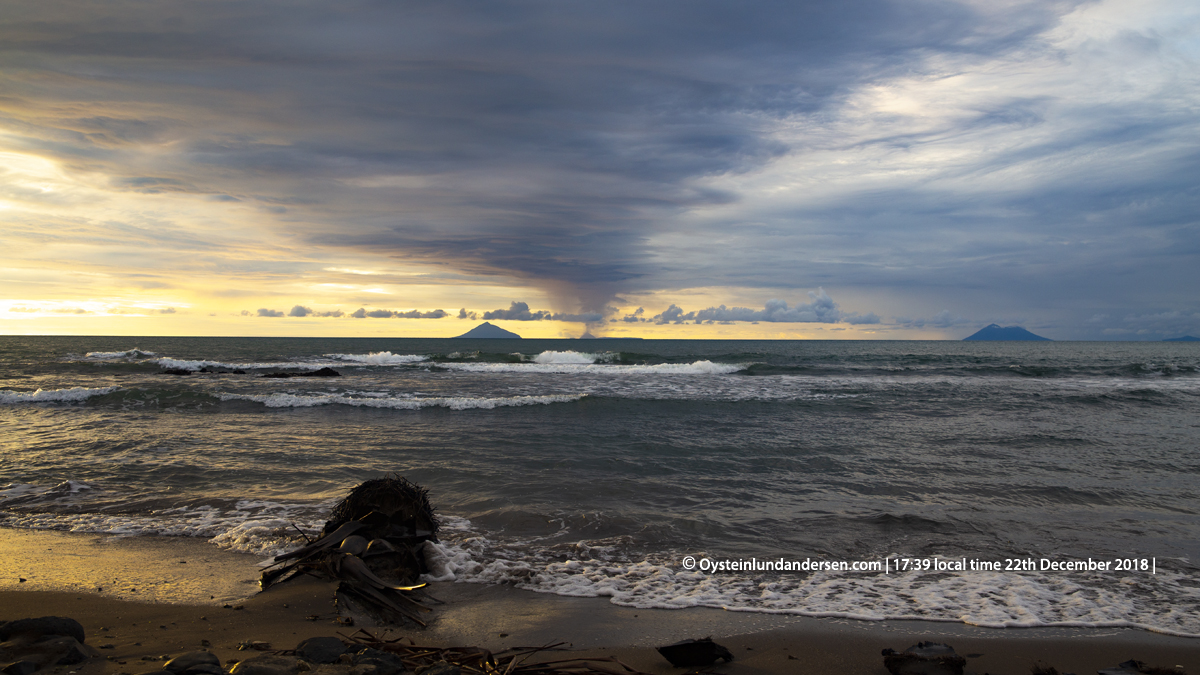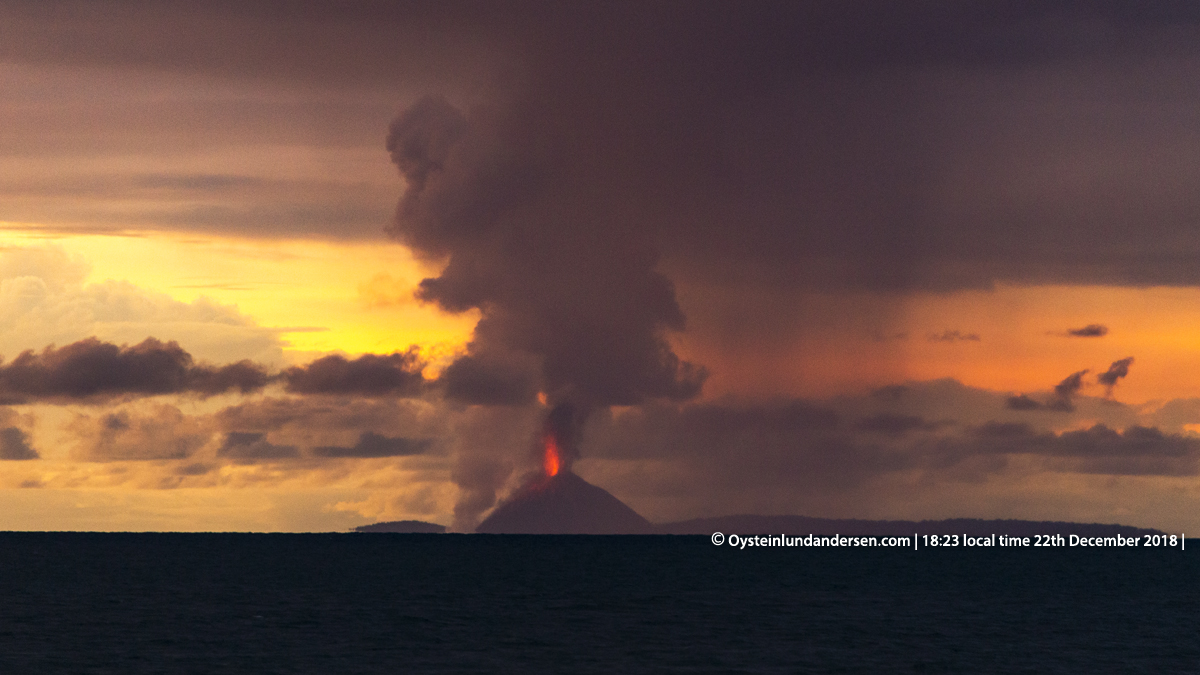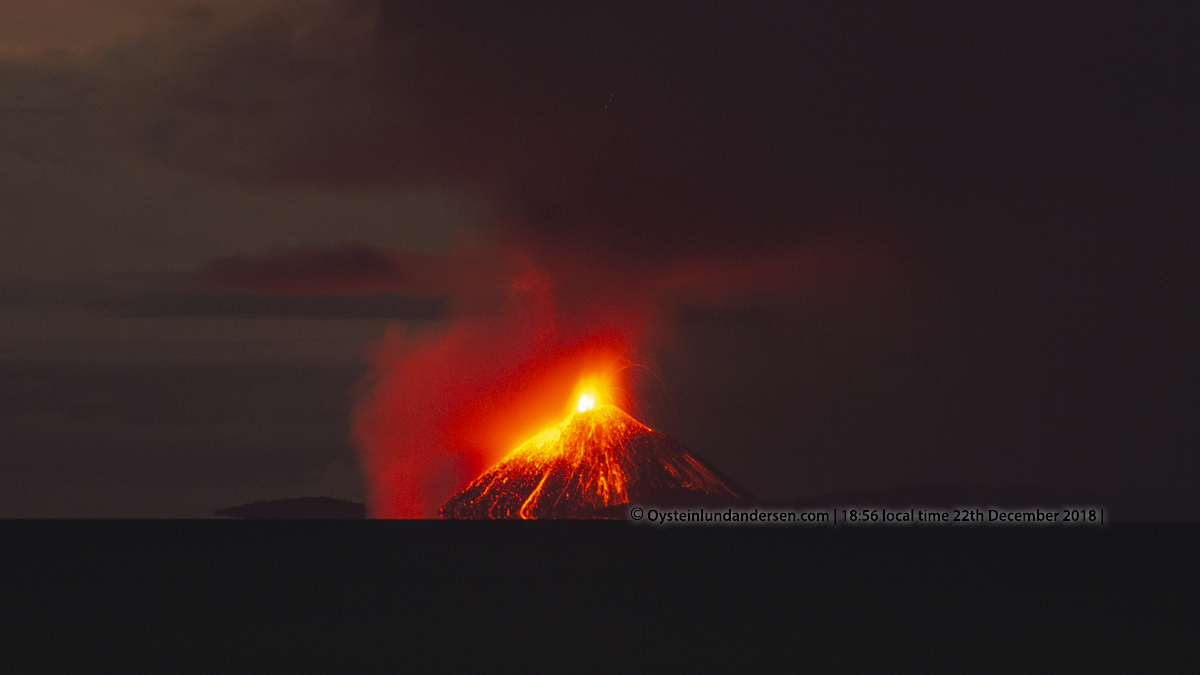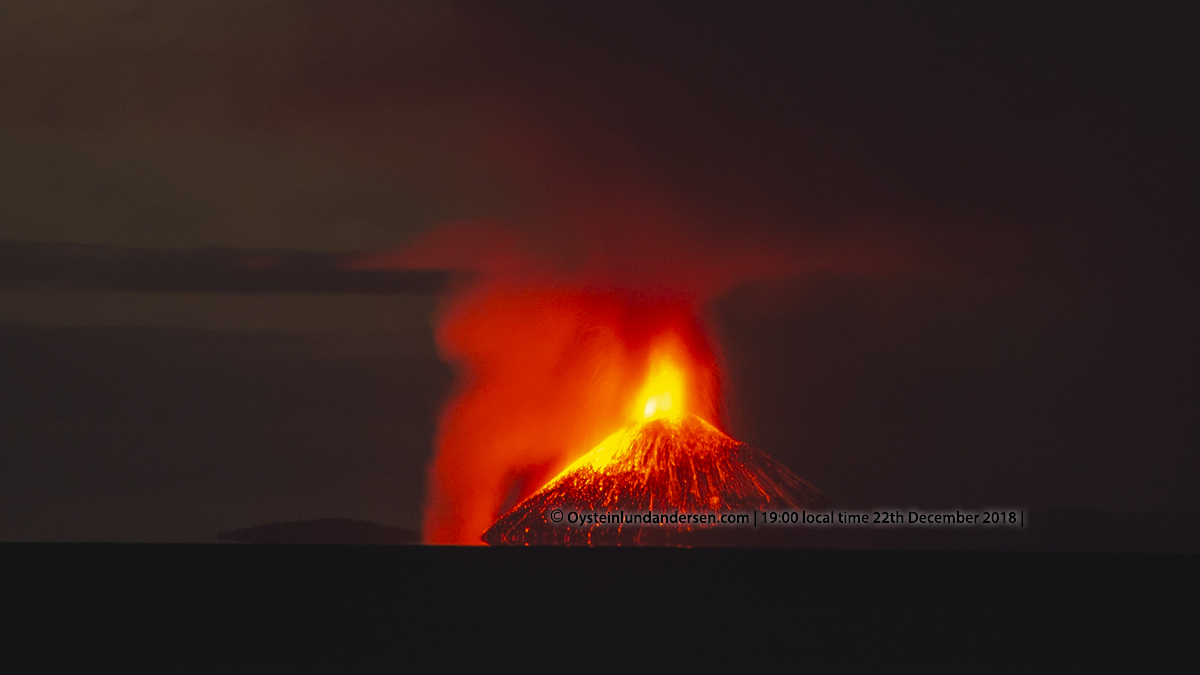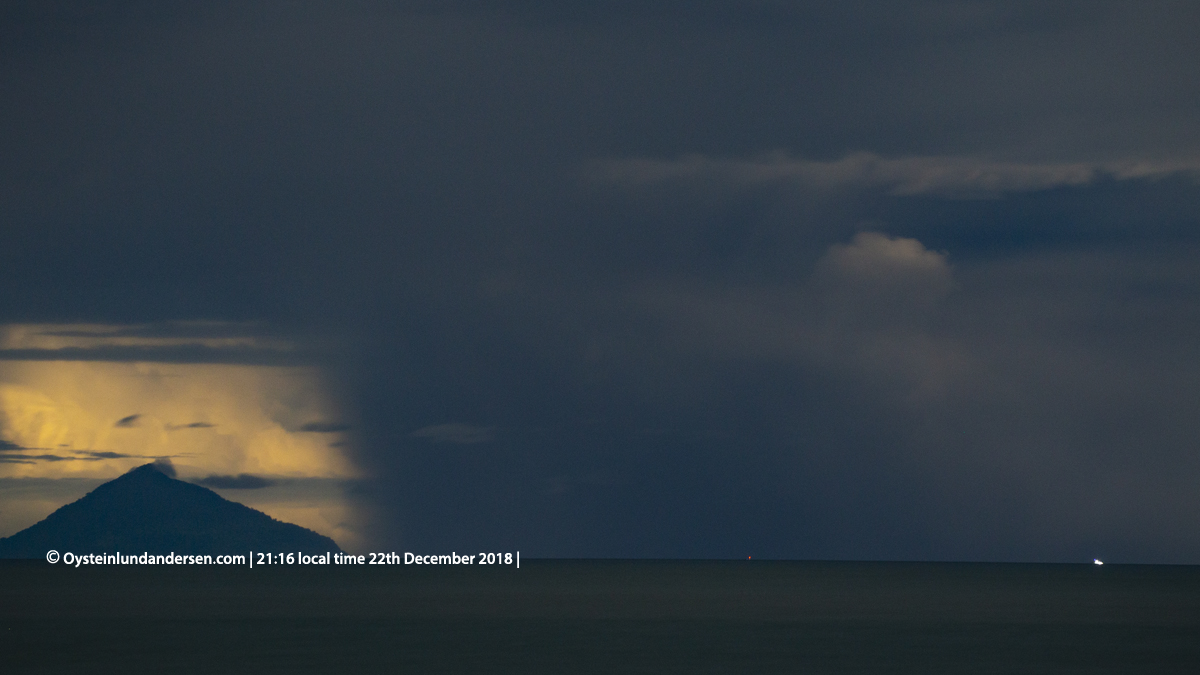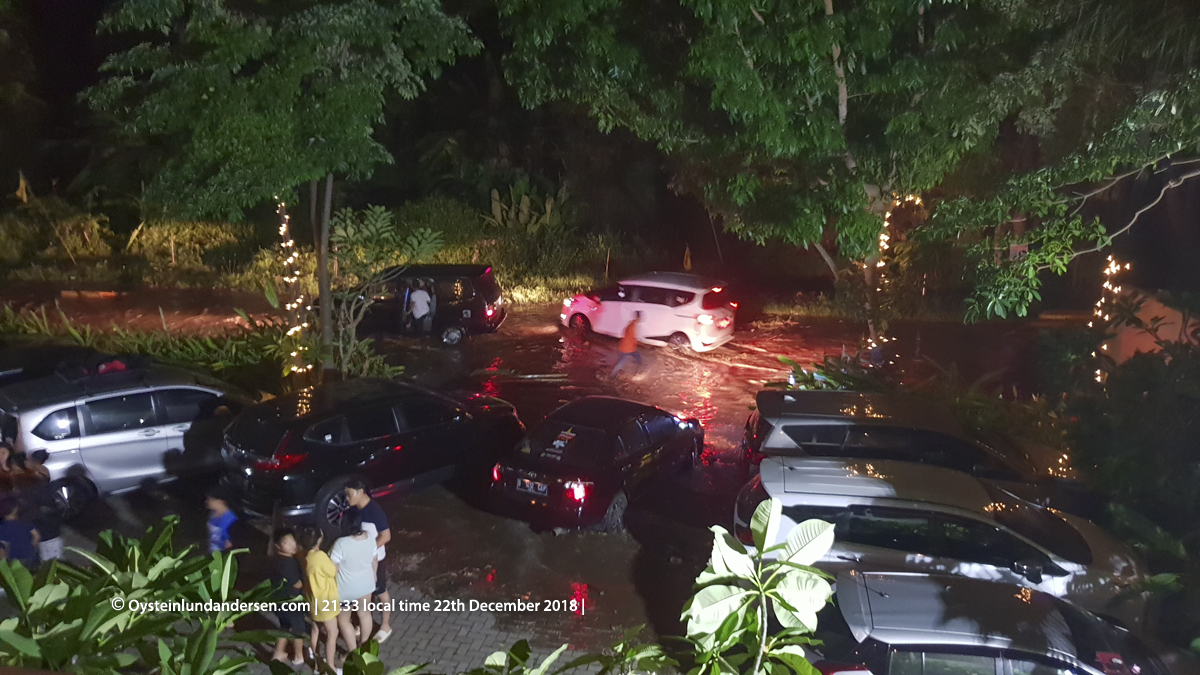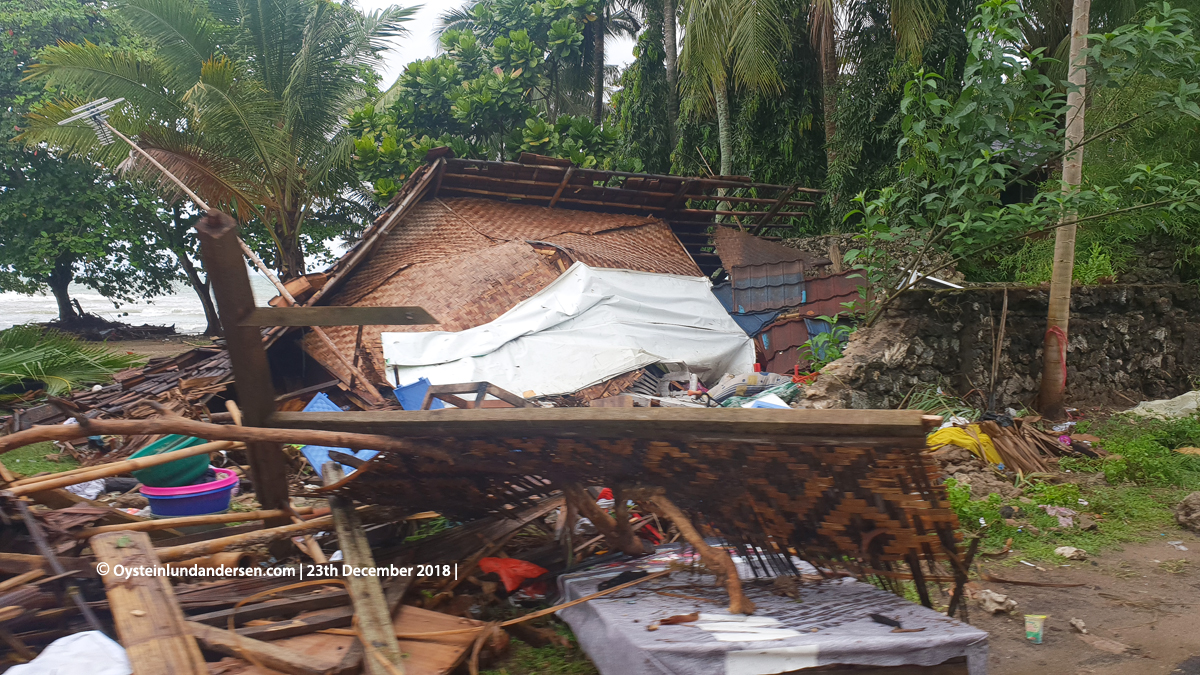Published: 26th December 2018.
Updated: 30th December (added comments in the section: Activity of the volcano)
Introduction
On the 22th December I was scheduled to arrive on the coast of Java (Anyer-Carita area), with the intention to stay for 2 nights. A trip I had planned for weeks with my family. I have made several trips to the area to observe Krakatau during the past year, especially after the new eruption cycle started in June. But this trip was not scheduled with the intention to observe the volcano. However I had brought my camera equipment as I had hoped to be lucky to get a few shots of the volcano. It would turn out to be a very different trip than I expected. I`ve decided to include a brief description on my observations of the Tsunami in this report too, as its a product of the volcano too.
Activity of the Volcano:
I arrived by car on the coast of Java around 13:45 local time on the 22th December, and because of the very clear weather conditions I were able to spot a eruption plume rising from Anak-Krakatau while driving to the hotel in Anyer-Carita.
At 14:29 I shot my first photos (see photo 1) of Krakatau from beside the beach of the hotel I was staying at, exactly 47km from Anak-Krakatau. (Photo 27 shows the location where I took the photos, with the incandescence Anak-Krakatau seen in the distance). In the beginning of my observation, Anak-Krakatau was producing a grey eruption plume that looked to contain ash, judging from the grey-black appearance of it. The plume seemed to reach heights of 900m or more. Eruption sounds were heard too, ranging from periods of every 10 sec., to every 30 sec, to periods where it was no eruption sounds. I got the impression that, eruption sounds were stronger, the less ash-rich the explosions. The eruption sounds from this distance, sounded to me like the sound of distant canon-fire. Sometimes you could also feel the pressure from the sound, and walls and windows sometimes would give off a shaking sound. (in July 2018 I recorded this sound of Anak-Krakatau erupting from this distance, listen to the sounds here, use a headset)
At around 17:00 the eruption seem to increase in intensity, as the ash plume seemed to increase in height and the eruption sounds became more frequent. Volcanic lightning was observed (visible in the video material). A white plume started to rise from the seashore of the Southern flank of Anak-Krakatau.(see photo 9.) In August and November I observed similar plumes from the Southern-flank, and both these times they were caused by lava-flows descending the flank and meeting the ocean, and subsequently producing steam plumes and mild-explosions. Therefore I think it is likely that the white-plume observed on this day also could be from a lava-flow.
After sunset the activity was still high, and red lava was seen being continuously ejected from the volcano, to heights sometimes exceeding the height of Anak-Krakatau from the looks of it. (see photo 19 & onwards). Because of the favorable clarity this evening, you could also see the individual ballistics/lava bombs showering the flanks, trough the zoom lens of the camera. (example photo 23.)
At around or after 18:30 the activity was as its peak during my observation. Eruption sounds became somewhat stronger, and the white plume that were rising from the Southern shore of Anak-Krakatau seemed to get more intense, and taller. The plume from the were rising from the shore was mostly white, but a few instances of grey plume also became visual at times (I figure this is small ash-plumes that were produced in explosions when hot lava came in contact with sea water.)
A majority of the erupted material seemed (as have been the case on every observation this autumn) to land on the S/SW flank of Anak-Krakatau. In photo 22, the height of the plume rising from the lava flow seem to exceed the height of the eruption plume. It is also worth noting that the lava-flow was glowing very strongly, glow from it made the plume glow red, to heights of maybe 6-700m. I have not seen such strong glow from a lava-flow on the flank of Anak-Krakatau ever before. I figure the reason of the strong glow, could be that the part (area) of the lava-flow that met with the ocean was big. Looking at the photos/video material captured this evening, it was obvious that the amount of lava ejected in that direction was big. Photo 24-26 show how strong the incandescence and eruption was from Anak-Krakatau this evening. At around 19:00 the eruption became more ash-rich. In the video acquired at this time the red glow from the heat of the eruption became engulfed in black, above the summit crater. I assume this is because of the ash erupted, since incandescent material (ballistics) can frequently been seen flying out of the dark area (ash rich eruption plume).
At 19:08 I took a break from my observations, and return to my hotel that was located next to the beach. While having dinner in the hotel, i could still hear the strong eruption sounds from Anak-Krakatau, as described above. Between approximately 20:30 and 21:00 I noticed that the eruption sounds had stopped. I did not give it any extra thought, as this have happened before during the day and on other trips when observing Krakatau, from this distance.
At around 21:05 I arrived at the beach again, and started rigging up my camera. I noticed I could not see the eruption or incandescence from Anak-Krakatau at this time. At 21:13 I took the first photo. Nothing visible around Anak-Krakatau. I zoom out on my camera to get more in the frame. My next photo (see photo 29) at 21:16 shows Anak-Krakatau shrouded in black, next to Rakata isl. I take a couple more photos. (last one being Photo no.30). Normally even tough a eruption has stopped, Incandescence from hot material tend to be observable for quite some time after the eruptive activity had ceased. This was not the case this time, as around and at the location of Anak-Krakatau, from my viewpoint it was pitch black. I remember thinking that is very strange. Rakata being only 4km from Anak-Krakatau, was however visible.
So while contemplating about this, suddenly I noticed that a odd incoming wave appear in the ocean in front of me, much higher than normal. (Time now is between 21:27-21:28.) . I realize quite fast that this wave will make it over the sandy beach to my position. (I was standing 10-12m inland from the edge of the ocean, 3m behind the edge of the beach). I grab my camera that is standing on a tripod and run inland trough the bushes. The terrain was gentle uphill. I look back when I had ran maybe 15m, and I see the wave had passed the beach and is still coming towards me but with decreased speed. Next time I turn back, I see the wave stop at about 15m inland from the edge of the beach. I stop for a brief moment, and I realize that this could not have been a normal wave. I continue up trough the bushes a minute until i meet the road and go in trough the back of my hotel that was located 25m to the right. In the lobby I see people have noticed the wave, as it slammed against the front part of the hotel property. The hotel building itself is located maybe 4-5m above sea-level, and lowest part of the property at approximately 3m above sea-level. While i stand there I look out trough the door towards the pool area. I could hear the ocean as you normally would if standing here. Suddenly I could not hear the ocean anymore. A few minutes have now passed since the first wave, time now is 21:31. I ran up to second floor into my hotel room and wake up my family. At this moment we all could hear a rumbling sound, and screams of guests in the hotel. The hotel gives off a small shake as the wave crashes into the property and passes our hotel on the right and left side. We start to pack a bag with the most essential stuff (water, some clothes). This second second tsunami wave struck between 21:31-32. At 21:33 I take a photo out towards the backside of our hotel. (see photo 31.)
Few minutes after this I decide to evacuate to higher ground with my family. Fortunately we manage to do this as most of the water had now flowed back (receded back) in the sea. Behind the hotel the terrain is slight uphill and we pass a forest (see photo 32. this is around 13min after the tsunami wave 2 hit) before meeting a path that leads us to a village. (see photo 33) We take refuge inland until the next day, in a house together with other who fled the situation. The place we stayed was 3km inland, about 50m+ height, 50km from Krakatau. (see photo 33)
I did not hear any more eruption sounds from Krakatau that evening (22th December). In the night a huge thunderstorm was active in the area so it would have been difficult to differentiate between thunder, if eruption sounds were present. I did not sleep during the night. At around 03:00 and onward until the morning, there were periods were the sound of the eruption of Krakatau became present. It sounded a bit different, occurred less frequent, but the sound had like a more heavy bass to it. There were several periods throughout the morning until early afternoon were i heard the eruption sounds.
At around 12:00 I visited the hotel I stayed at before the tsunami, to collect my stuff. Some areas next to my hotel was in ruins, as they were located close to sea-level. (see photo 34-36). The worst damaged buildings were those that were made of tree or bamboo. Other buildings that were located on slightly elevated land were spared. Cars had been pushed around and a few were upside down. The tsunami wave made medium damage to the hotel property area in front of my hotel, including destroying 2 bungalows (not for accommodation), tables and hotel signs. Being situated 3-5m above sea level spared the hotel and guests from major damage. As I understand no hotel guests from the hotel I stayed in received serious injuries.
I went back after this to the house in hill were my family now stayed. At around 15:00 we got news that the Indonesian authorities were finished clearing the road of debris, so we decided to drive back to Jakarta. I arrived by the coast again at around 15:30 en-route Jakarta, and stopped for a brief moment to try to spot Krakatau. Only Rakata was faintly visible on the horizon. It was rainy and very strong wind. No eruption sound heard, or eruption plume was visible from Krakatau at this point.
Note on the Tsunami waves:
`Tsunami wave no.1` occurred approximately between 21:27-21:28 local time*. I figure the height of the first Tsunami wave was around 1.5m tall, judging from my observation of it and how far I observed it to travel inland (15m inland from the edge of the beach), but also taking into consideration that the wave did not make it into the hotel area, as the hotel is situated on elevated ground approx. 3-5m over sea level.
Based on my calculation `Tsunami wave 2` started to arrive between 21:31-32*, 3-4 minutes after the first wave. It was higher and had more volume. It entered the hotel property area, and some water made it into the ground floor of the hotel (located approx 4-5m above sea-level). It made medium damage to the hotel property area in front of the hotel, including destroying 2 bungalows (not for accommodation), tables and hotel signs. Footage from the hotel CCTV camera, show the tsunami wave enter the hotel property, also shed light on the size and height of the wave. From the fact that the wave were able to enter the hotel area that is located on approx. 3m elevated ground and upwards, and that water splashed into the ground floor/lobby area that is situated at height of 4-5m above sea-level, and the fact that water made it around 40m inland past our hotel. I figure the height of the `Tsunami wave 2` must have been at least 3-4m high.
See photos and a video of the damage caused by the tsunami, photographed and filmed only around 12hours after the Tsunami waves hit the coast.
* I have pinpointed a approximate arrival time of the waves based on timestamps on my phone-camera and DSLR camera.
Image comparison between Anak-Krakatau on 1st July 2018 vs 22 December 2018.
I made this image comparison to show the approximate growth of the Anak-Krakatau cone between 1st July 2016 and 22 December 2018, with the main image showing the (red) outline of the 2016 cone on the 2018 cone. Both photos used were taken from the same location. As you can see, from this angle – Anak-Krakatau seem to have had most growth on the left (southern side) and upwards. The main volume of the new material have been added in 2018, since there wasn’t any significant eruptive activity in 2016 and 2017. If i am not mistaken, there are suggestions that the S/SW part of the cone was involved in the 22th December collapse. This image may however contain errors i`m not aware of. Please give me feedback if you have any, and I will add it to this article.
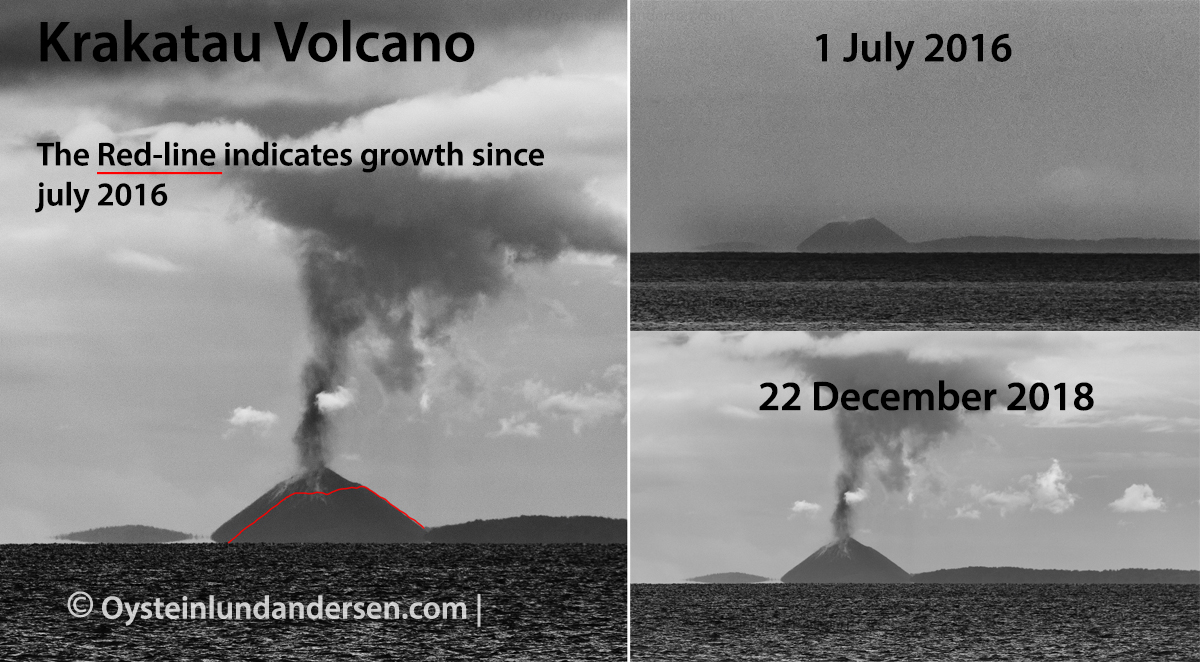

Concluding observation remarks
I have come to the conclusion that during the afternoon of 22th December, I witnessed the most intense eruptive activity I have observed at Anak-Krakatau. I have been following the eruption cycle since it started in June 2018, trough the CCTV almost daily (when weather conditions allowed it and when it was operational) and I have visited the volcano 2 times in 2018, but also observed it 3 times erupting from the coast of Java. (Last time being in November).
Only 2 previous times I have heard eruption sounds from Anak-Krakatau in 2018, this was in July and August. (see links to reports below). However im aware it have occurred in a few other periods too.
When I started observing Krakatau on the evening of the 22th December around 21:05, I became baffled that even tough the volcano was not erupting anymore at this point, Incandescence from hot material wasn’t observable, and it was all black around Anak-krakatau. Then the tsunami arrived. Later the next day when i opened my photos again, I started to examine them. I saw what looked like a “dark cloud” above, and covering Anak-Krakatau. (see photo 29.). I assume now, that when I took this photo the collapse (landslide) that took with it a majority of the volcanic island into the ocean, had just occurred minutes prior to this. I also assume that this “dark cloud” I see in these photos, were actually a dense eruption plume and steam that covers the whole island, so that it made Anak-Krakatau not visible to my eyes or the camera. These particular photos are probably the first photos taken toward Anak-Krakatau, after the collapse. As the collapse/landslide on the 22th December occurred only minutes prior to the photo being taken*. Photo 28. is on the contrary maybe one of the last (if not the last) photo taken of Anak-Krakatau while having “its old-shape”, before the collapse.
Although the eruption were strong and intense in the hours before the Tsunami, I never thought or could have predicted that the eruption (Anak-Krakatau) would produce any tsunami. The restriction/danger zone recommended by the Indonesian authorities (PVMBG/MAGMA) was at this point at only 2km from Anak-Krakatau – I were 47km from it. In addition to this, Krakatau haven’t produced any Tsunami in 135 years (since 1883) that Im aware of, so it felt like a unlikely scenario to me – although the unlikely actually happened this day.
I have tried to write my experience above to the best of my knowledge. I have often used time-stamps from my phone-camera and DSLR camera to pinpoint the time something occurred. The photos and video material posted below should give the reader of this report his own visual impressions of the eruption and to some extent – damage caused by the tsunami. I have uploaded a 40min unedited video of the eruption filmed between 18:09 – 18:52 local time also, to ensure the reader, get to see what I saw during the hours before the fatal collapse and tsunami.
* Some sources say the collapse occurred around 21:00-21:05 local time. But this is not confirmed.
Links to my previous observations of Krakatau in 2018:
Thank you
We are very thankful to have come out of this situation unharmed. Our thoughts are with the people harmed in this natural catastrophe, their families and to the Indonesian authorities who has challenging tasks in dealing with the situation on the West Coast of Java and Southern parts of Sumatra as of today.
While fleeing the coast uphill into safety we were taken care of with open arms by the villagers of Anyer. Staff from our hotel also found us, and offered us drinks and snacks. The hotel managed to gather most of the hotel guests, and offered us a house to stay in together. Women and children were given the rooms to sleep in, while we men stayed outside and slept on the floor on madrases of this wall-less house. But it was clean, we had electricity and staff cooked food for everyone – during our whole stay. We felt safe. So to make it very clear, I’m very thankful for how we were taken of and treated in this difficult situation. A special thanks to the good people of Anyer and to the staff, and owner, of our hotel.
Important Note:
This is my personal notes, and should not be considered as Official information regarding the volcano or its activity. For updated information and official statements on the volcanic activity of Krakatau Volcano, visit the Indonesian authorities website MAGMA Indonesia. and Center for Volcanology and Geological Hazard Mitigation`(PVMBG). On Twitter (@id_magma and @vulkanologi_mbg)
The restriction/danger zone for Anak-Krakatau is currently (as of 27th December 2018) at 5km from the summit-crater of Anak-Krakatau, recommended by the Indonesian `Center for Volcanology and Geology. The volcano is at Level 3 (Orange/Siaga as of 27th December 2018.)
____________________
Total photos in this article: 36. (Available in Jpg/Raw.). (150+ photos not published)
Total videos: 4. (Available in 4K).
Photos and Videos published are available for purchase only. If you want to purchase photos or videos, please see this page
____________________
Photos 22-23th December


